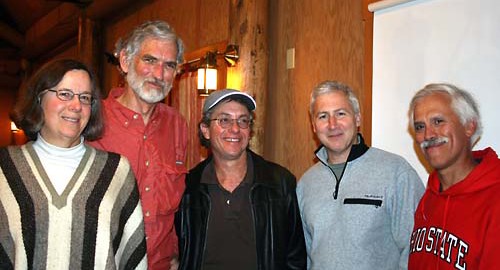How and when did the class start?
It started on paper at the college campus before it started in the woods. I had a backpacking class that didn’t work. People didn’t want to hike. I then tried a shorter backpacking class and it didn’t work, either. People weren’t interested in putting packs on, so eventually I hit on the idea that we would camp at Mazama Campground. We wouldn’t carry anything with us and we would do these days hikes. From the campground we’d drive out to points of interest and day hike. It seemed to be the ticket to get people interested in hiking in the park. I challenged myself to take them places they wouldn’t typically go. When someone drives to Crater Lake and gets out of their car and walks over to the rim, they probably wouldn’t include a hike to Boundary Springs. I try to take them places that maybe the Park Service wouldn’t suggest to everyone. One hike we enjoy doing is the Dutton Creek Trial. We hike down from the rim, toward Mazama Campground. That’s not amazing to people who work in the park, but it’s really unusual to go from being shoulder to shoulder with people on the rim and in five minutes being completely alone in the forest. Crater Lake is a place where that happens—you can take just a few steps down a trail and not have any idea that there are thousands of people behind you in the parking lot. Most people don’t go down these trails. My challenge is to get this group of people away from the main haunts of the park. It’s not hard to do, not hard to do at all.
Do you bring limnology into the class?
I do. Each year I try to focus on a different specialty. One year we actually hiked up to the Whitehorse Ponds area where I did a project for the Crater Lake Natural History Association. Another year I took the group to Diamond Lake, brought them out on my boat and showed them how to do zooplankton tows. That was true limnology. The Whitehorse Ponds study (22)—involved temperature measurements as well as identifying plants and animals tracks in some of the mud up there. In other years I’ve taken them to do some stream work. They enjoyed surveying Lost Creek one year. I call that the lab segment of the field studies.
The field studies are a three day commitment. The lab segment, which is a separate credit, involves a fourth day. We do something a little bit more rigorous on that fourth day. We actually measure and look at the water more specifically, or whatever we’re intensely studying that year. Last year we had Ron Mastrogiuseppe give an excellent workshop on fire ecology. He actually had students measuring trees and taking data. After we arrived in Grants Pass, we plotted all this date and looked at young, middle-aged, and older trees that had survived, or had grown, since the fire had gone through that area in the Panhandle. I try to do something different each year and it helps me to stay excited about taking groups up there. We also camped at Lost Creek Campground last year for the first time. That was different than Mazama—there are no showers.


